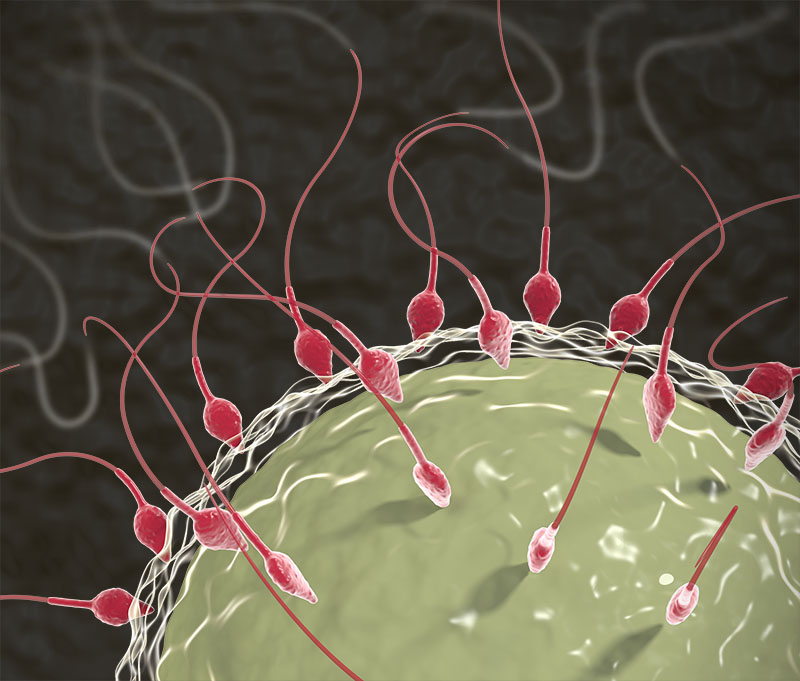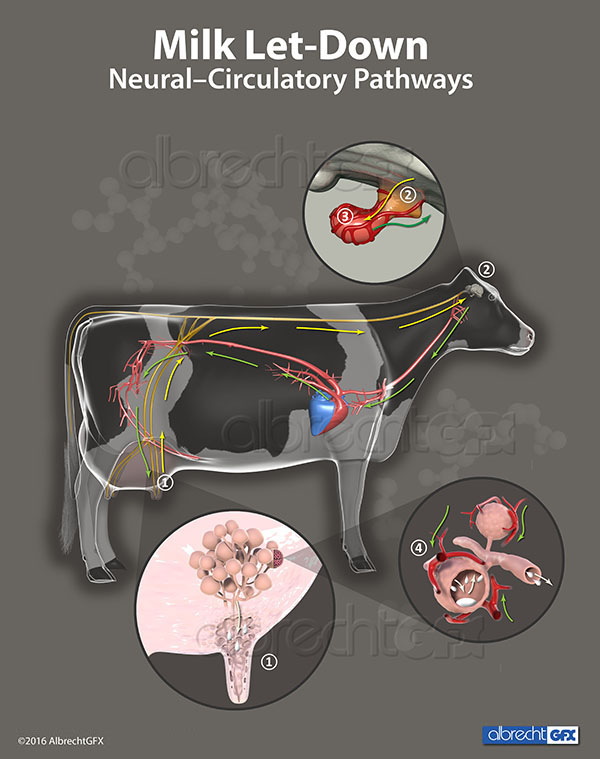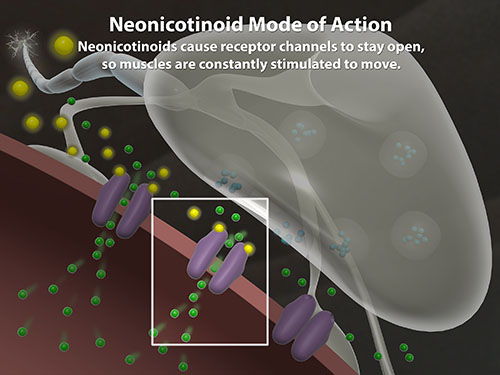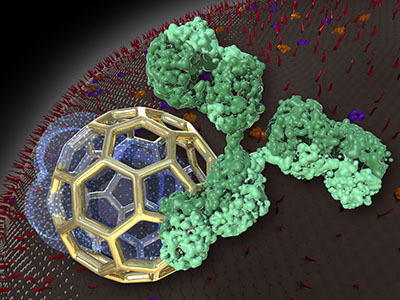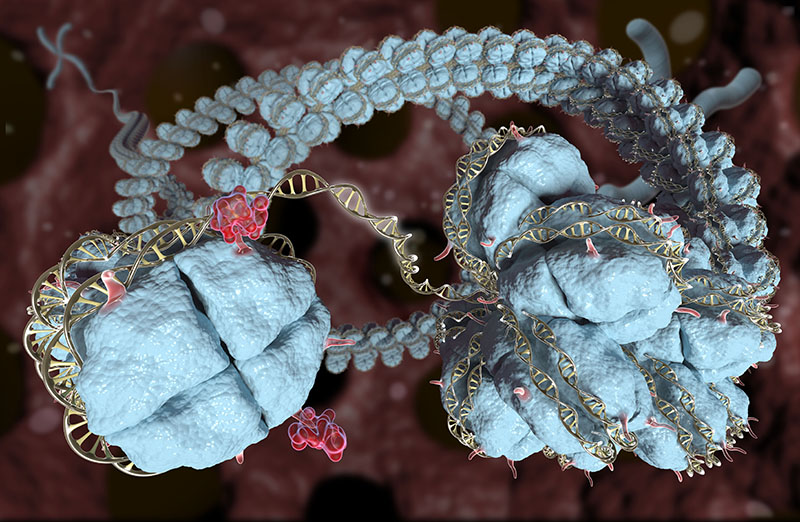Owning a business is not easy, but it has a few incredible benefits. One of those perks is the opportunity to focus our 3D illustration / animation company capabilities on subject matter of personal interest and curiosity. For us, that subject is biological science.
Our online gallery includes visuals related to both plants and animals. The gallery has a few graphics related to plants, but the majority are micro, macro, cellular depictions of animal species, e.g. cattle, horses, pigs, cats, dogs, humans.
We use 3D illustration and animation tools to make biological content available and understandable to a worldwide audience– crossing language barriers and levels of technical knowledge.
Milk Let-down Infographic
Pictured here is a molecular sequence that occurs every day in dairy milking parlors–milk let-down.
The chain of events involved in milk let-down is difficult to show because the sequence involves both the nervous system and circulatory system throughout the body. We’ve used numbers, callouts of specific body regions, and colored arrows to trace the pathway through the body.
As good as this illustration is, we think animation makes this idea easier to understand. As I write this, Don is working on the animation. We’ll post a link to the animation when it is available.
(1)Teat suckling (by calf or milking machine) sends nerve impulses to the brain’s hypothalamus(2) and on to the pituitary(3). The pituitary gland secrets oxytocin into the blood stream, which carries it to udder alveoli(4). Udder alveoli contract to let down milk.
Yellow arrows = nervous system pathway
Green arrows = circulatory system pathway
Note: oxytocin molecule in background
Trade Show Graphics
The illustration above shows nematodes in the soil ready to feast on soybean roots. It’s a bold image and a favorite of mine that we often use in our trade show exhibit.
With a trade show coming up, we’re reviewing all of our display graphics. Our illustrations cover macro, micro, and cellular level depictions of topics such as: respiratory issues, nutrition, immunity, and genetics. We look for eye-catching, vibrant visuals that have broad content appeal and connect with our audience: researchers, sales/marketing and training professionals, and advertising agencies.
We are successful when trade show attendees see visually appealing graphics that pique an interest in the subject matter and what we do: convert technical content into visuals that appeal to both technical and non-technical audiences.
Zika Virus in the News
Project FAQ
The Basics.
It’s possible that someone reading this blog has never worked with a scientific illustrator / animator. Here’s what we’d like you to know about AlbrechtGFX projects:
Who owns the completed project?
The client. Our work is considered “for hire,” that is, we relinquish all rights to the finished illustration / animation. Clients are free to use the illustration / animation as they choose and as often as they want. Forever.
How long will it take to finish an illustration? How much will it cost?
These two questions are the ones most people want answered. They’re the questions I’d want answered too.
The problem is, no project is exactly like another. Each illustration and animation is unique, as are the variables surrounding the project. For that reason, we are most comfortable providing a cost/time estimate range based on expected time and materials used to complete a project. If questions, please contact me @+1.402.786.3636.
What about the scientific / technical accuracy of an illustration?
Your subject matter expert (SME) is the ultimate authority. We research every project in order to ask questions, discuss content with your SME before beginning illustration. That way, your SME will quickly sign-off on the final illustration.
Planning an Animated Video
First Animated Video
We’ve met savvy professionals who know a 3D animated video is just what they need to explain a process, showcase product features, etc. Sometimes there is a problem. How, where to begin? There are always questions surrounding animated video productions. Here are some points to consider when beginning such a project.
Planning an animated video
– How will you use the completed animated video? Website, presentation, trade show?
– Identify key concepts, steps in process, etc., that must be included. Make an outline.
– Identify key scenes that occur within that sequence. What visuals are most needed to make your point(s)?
– Identify and collect existing content for use as visuals in the animation, e.g., photos, company, product logo, animations, print material, etc.
– If you don’t have time or personnel to perform the tasks above, hire a consultant or agency to do it for you.
Creating an initial animation audio script
– Talk through the information as though you were giving a presentation. Record the presentation.
– Transcribe the audio. That is your initial audio script.
– Refine the initial audio script. FYI, the average US English speaking rate is approximately 125 – 150 words per minute. Adjust your audio script to fit your desired (We can make general suggestions, but we are not writers. We can suggest experienced professional writers to help write or polish your audio script.)
General information for planning animation:
– The more organized the project, the less time / $ to produce.
– Plan the project so your technical experts and project stakeholders are available to give feedback, approve content, etc in a timely way. We provide an estimate of in-house production time to complete a project and a project. This estimate won’t include client approval time.
Want more information? Contact AlbrechtGFX
+.402.786.3636 info@albrechtgfx.com
We have years of experience in creating animated videos for scientific, bio-tech companies and the advertising agencies that assist them.
“Curiouser and Curiouser”*
Our illustration at right, “Gene Regulated Transcription,” appeared in last year’s Medical Illustration SourceBook. Briefly, the illustration shows an unwound segment of DNA made available for use as a blueprint to create, e.g., cell membranes, enzymes, hormones, etc.
I loved the illustration but wasn’t keen on submitting it to the SourceBook– the science behind the illustration is complicated, complex, and far-removed from our everyday experiences.
Now there is a book by Pulitzer Prize winning science reporter / author, Amy Ellis Nutt, that connects the world of genes and DNA to people in the world around us. Becoming Nicole is the true story of two identical twin boys who had obvious differences in gender identification from an early age. Identical twins with identical DNA, but variation in genetic blueprint reading resulted in twins that are no longer identical.
*Lewis Carroll from Alice’s Adventures in Wonderland & Through the Looking-Glass
Awesome Science
In our business, we often work with scientists, researchers, and technical experts. As a non-scientist, I am in continually in awe of the discoveries and efforts to make the world a better place to live, e.g., last week’s announcement by the Nobel Prize in Chemistry for work in mapping cell repair of damaged DNA on a molecular level.
2015 Nobel Prize in Chemistry Press Release:
“The Nobel Prize in Chemistry 2015 is awarded to Tomas Lindahl, Paul Modrich and Aziz Sancar for having mapped, at a molecular level, how cells repair damaged DNA and safeguard the genetic information. Their work has provided fundamental knowledge of how a living cell functions and is, for instance, used for the development of new cancer treatments.”
New Perspective
Our workday starts like it does for many people, a quick meeting over coffee to discuss what we’re working on today, what needs to be done next. The rest of the day, Don and I typically work alone. Not action-packed, but what is needed to get technical projects right.
Last week was different. We attended a large international trade show. It was fantastic to be out of the office for a few days–seeing people we knew, meeting others we didn’t, learning something from everyone.
Visiting booths, listening to company reps, reading product literature, talking to other attendees was both exhausting and energizing. We have a better understanding of current industry trends and the changing landscape for scientific / biotech companies: more technical content, increasing international presence, efforts to widen market reach to more diverse audiences. We’ll try to incorporate last week’s experiences as we’re back working on projects.
Size Matters
I mentioned earlier that we are a small company. That’s by choice. We find it’s easier and more satisfying to concentrate on doing work we want to do in the biological sciences. It also happens to be a good model for our business.
When clients come to us, they work with Don, a 3D illustrator / animator accustomed to working with technical content discussions with subject matter experts. Don translates scientific / biological discoveries into 3D illustrations / animations that explain why those findings are important to a larger audience. For example, a client’s product may have a mode of action that works faster and / or is more effective. Our illustrations / animations are visual reminder of our client’s significant investment in company & product branding, R & D, technical service.

